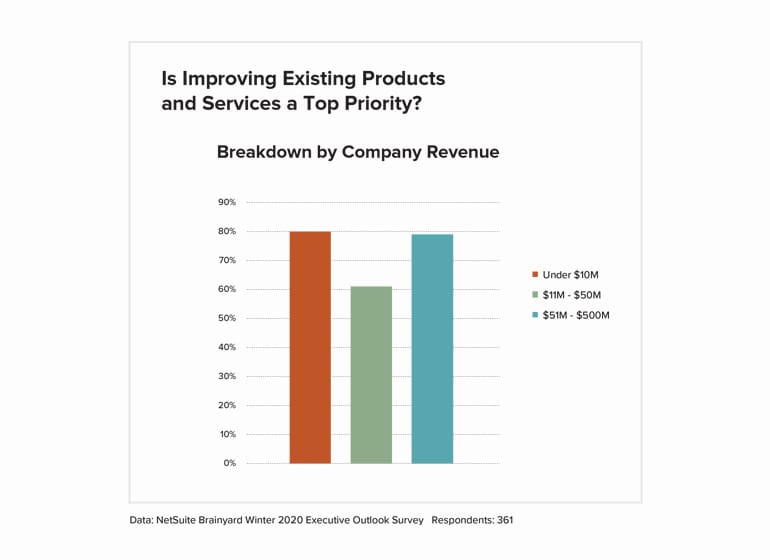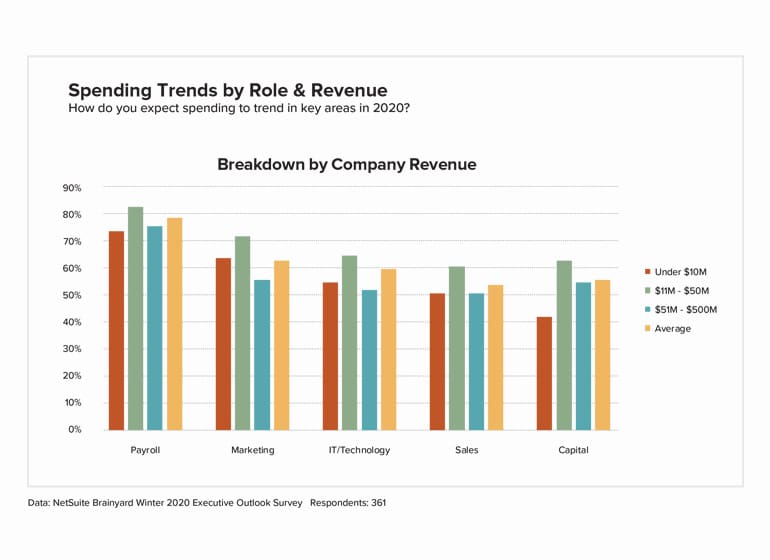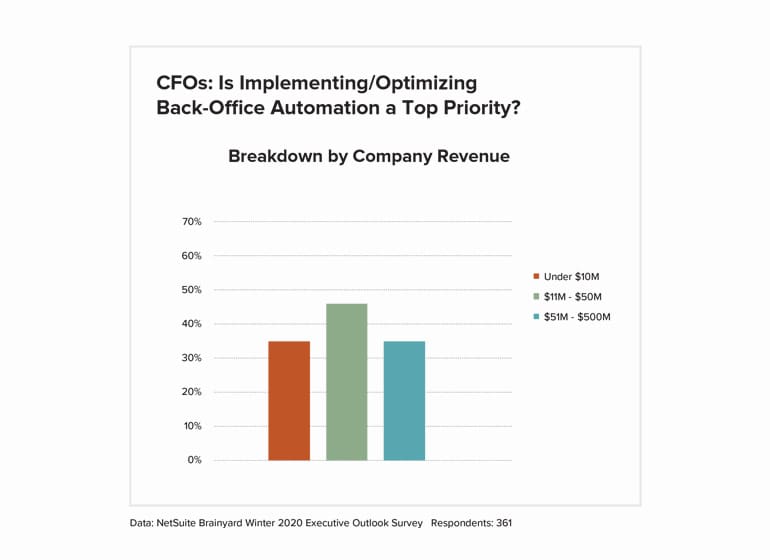In short:
- When companies reach about $10 million in annual revenue, they tend to outgrow the systems and processes that got them there.
- At this critical point, it's time to invest in new technology and build new processes that will fuel the next stage of growth — to $50 million.
- In this introduction to a series, we'll illustrate your $10 million company's current position and outline our plan to help you gear up for growth.
The federal government’s nomenclature regarding business size is, in a word, unfortunate. The Commerce Department defines small businesses as those with fewer than 100 employees, making 89% of U.S. businesses “small.” The median business size in the U.S. is somewhere around three employees, so if you’ve grown a business thirty times larger than the median, we’re not going to agree with a convention that calls it small.
However, when companies reach roughly 100 employees or $10 million in annual revenue, we’ve consistently seen them outgrow many of the processes and systems that used to work just fine. Sometimes the pain hits earlier, at $5 million, and sometimes it’s closer to $15 million, but sooner or later, it’s time for scalable systems. Inventory management by clipboard and spreadsheet becomes unwieldy. Letting sales teams track customers and prospects ad hoc becomes unproductive. Continued growth requires a data-driven approach to marketing. And so it goes, department by department.
Our goal with this series of articles is to help business leaders, particularly finance leaders, navigate the transition from what the Commerce Department terms small business to medium business — that is, beyond 100 employees and $10 million in annual revenue, toward $50 million. We’ll do it with practical, actionable advice that broadly applies business and technology best practices for the current times.
Get an overview of Project $50 Million:
Why $10 Million?
In our pre-pandemic surveys, we found that businesses with revenues in the $10 million to $50 million range are less likely to focus on improving existing products and services and more likely to spend on other business fundamentals like payroll and marketing. Leaders essentially let up on the growth gas pedal to address real issues around internal processes, systems and expertise to remove impediments to sustained future growth.


In particular, CFOs at companies just over $10 million more likely want to spend on business process automation than their peers at smaller and larger companies. The implication is clear: Smaller companies have yet to feel the pain that drives such investment, and larger companies are more likely to have already done the work. In this series, we’ll look at not only the new tools you’ll need to automate your business past its growth pains but also the data which these tools will allow you to collect and the organizational changes required to use that data and reset for growth.

It’s particularly telling that the above data was gathered in late 2019 when the economy was stable and had been growing for years. The instability of 2020 had most business leaders we surveyed focusing less on product tweaks and more on internal systems and crisis management. The few who did make product adjustments, like manufacturers that morphed into PPE makers, got a lot of press for doing so. Remote work and internet-based sales and marketing took off during the year — all while cash flow management remained a constant concern.
The effort to improve internal systems mostly worked in 2020. Companies not only found new paths to sales and a new level of comfort with remote work, but they also found that the technology and processes they adopted made them more efficient and provided better data than their old ways of getting things done.
Change When Change Isn’t Existential
In 2020, necessity drove technology adoption, as well as the earnest effort to use it well. As the economy rights itself, technology adoption doesn’t feel quite as critical, though it’s still high on the priority list for many companies, according to our most recent survey, from December 2020. That and some overly optimistic estimates of likely benefits, possibly encouraged by aggressive sales people, often leave technology adopters feeling as though they didn’t get what they expected, per a McKinsey survey on the industrial application of cloud technology .
It can happen with any new process: Think about the last time you tried to keep a regular gym schedule or lose 20 pounds or read two books a month. Intentions often don’t match up to results. New, sophisticated software, in particular, has a learning curve, and not every employee is excited about learning a new way to do what they’ve done for years. But some factors make it more appealing, which in turn make the tool seem more worthwhile to management.
Take the example of adopting customer relationship management (CRM) software. Every minute your salespeople spend learning the new CRM is a minute they aren’t interacting with customers. Some will be more sensitive to that than others. If entering the office is impossible, and therefore accessing written notes or legacy systems isn’t possible, there will obviously be less hesitancy to use a new tool. And there’s even less hesitancy if legacy data has been migrated into the new system. In that case, universal adoption is likely, and that’s going to make the new CRM seem like a good investment.

18 Ways to Automate Your Business for Growth: All businesses want to do more with less. Automation makes it possible to perform more work with fewer people and free up time for innovating ways to generate more profit.
Universal use, however, doesn’t mean extensive use. CRMs can be incredibly powerful tools that will help manage sales funnels, reduce customer churn and even automate production of contracts and statements of work (SOWs) — but only if use is thorough and consistent. Great salespeople are often innovative rule-breakers who thrive on human interaction and persuasion. Those aren’t the characteristics typically ascribed to detail-oriented technology users. The McKinsey team behind that survey we referenced would like you to hire their company to fix that problem. We’d like you to train or hire a sales admin whose primary function is to optimize the use of your new platform.
We know that advice is likely met with a deep eye roll. If you follow it, not only do you need to pay the recurring fee for the application and train your sales team, but you also need to dedicate some or all of an employee’s time to become an expert user and adjust processes accordingly. That is indeed a substantial investment — but the return is equally large. Sales managers will get a way to ensure that funnels are worked and leads are nurtured. Sales pros will get more out than they put in, because the sales admin is helping them. When contracts and SOWs are automatically produced and consistent, operations teams will have a much easier job of reviewing them. Likewise, finance teams won’t need to spend as much time on terms and conditions when they review new deals, because they’re automatically consistent.
The other benefit is scale. Depending on the complexity of your typical sale, one sales admin can usually work with as many 10 salespeople. It’s pretty clear that one proficient administrative user will pay for himself if he saves each salesperson three or four hours a week while producing superior output that also lightens the load for operations and finance.
Plus, some expert help with a CRM can help salespeople go from focusing on only new business to looking after customers throughout their lifecycle with the company.
Project $50M: future coverage
In future articles,
we’ll outline strategies by business function, such as:
Ecommerce for Services Orgs
Ecommerce for Product Orgs
Advanced
Supply Chain Management
Advanced Inventory Management
Advanced
Project Management
Finance Automation
Staffing: Chief Revenue
Officer
Marketing Automation
Raising Capital
People, Process and Technology
These are the sorts of people, process and technology discussions we’ll bring you throughout this series. Our aim is to help you think through the business of doing business. We can’t help you build better widgets or provide smarter services; that’s intellectual property that you own. But we can help you build a better, smarter, more efficient support structure that will scale with your business.
Scale and efficiency are the biggest challenges for $10 million businesses. Economies of scale are very real, and business growth gurus often miss that point. Big business often feels inefficient, but when you calculate productivity on a per-employee basis, the big firms have a substantial advantage.
Check it for yourself — but stay within your vertical, as that makes a huge difference when comparing revenue per employee. For example, the retailer Gap, with its many stores and associates, sits at about 200 on the Fortune 500 list and has a revenue per employee of $127,000. Mastercard is slightly up the list at 191, with about 2% more revenue than Gap, but its per employee revenue is over $900,000, according to Fortune’s data. In comparable industries, revenue per employee for $10 million companies is about one-third that of their Fortune 500 kin and about half that of companies who’ve just made it into the billion-dollar club. Energy, pharma and financial services companies do the best on a per-employee basis. For example, ExxonMobil generates $3.5 million per employee. On average, $10 million companies have around 100 employees on payroll, and thus $100,000 in revenue per employee, but their figures too vary widely by industry.
A significant goal of most system and process upgrades should be to improve revenue per employee, because that’s what it will take to compete successfully at $50 million and beyond. In our CRM example, you may add a FTE to get the most out of your new customer management system, but the improved efficiency and better process adherence of the sales team should lead to improved sales and less churn.
More importantly, if a company with $1 billion in revenue decides it needs better inventory management software, it can throw five people and a consultant at the job of determining requirements and ultimately which system it should use. Meanwhile, at the $10 million company, it’ll be a couple of existing employees who take on the project alongside their regular duties. So, in this series, we’ll avoid recommending million-dollar projects that take six months and a dedicated team to implement and even longer to show a positive ROI.
Keeping It Real
Finally, we’ll avoid recommending technologies that haven’t been deeply integrated into systems. There’s a lot of talk about newer technologies like IoT, blockchain and artificial intelligence. All are interesting technologies with good application in business — but it’s the application that truly counts. If you found a great supply chain management system that met your needs and was affordable, would it really matter whether it used blockchain? We don’t think so. That’s not to say blockchain won’t someday greatly benefit supply chains; the current NFT craze and digital currency interest is demonstrating blockchain’s utility for tracking, buying and selling items of value. If you choose the right tech partner, though, those benefits will come. It’s the rare case that companies in the $10 million to $50 million range are wise to adopt bleeding-edge technologies. Fortune 500 firms have a hard enough time harnessing speculative technology. Let them spend to hone the application while you concentrate on proven systems that scale.
The Bottom Line
At a critical point, companies with around $10 million encounter a need to pause, rethink and gear up for the next long hike of growth — if they indeed accept the invitation to make that hike. If you’re feeling that need for growth pause coming on, we hope you’ll embrace it. We further hope that our series will help you map out your route to $50 million and beyond.









